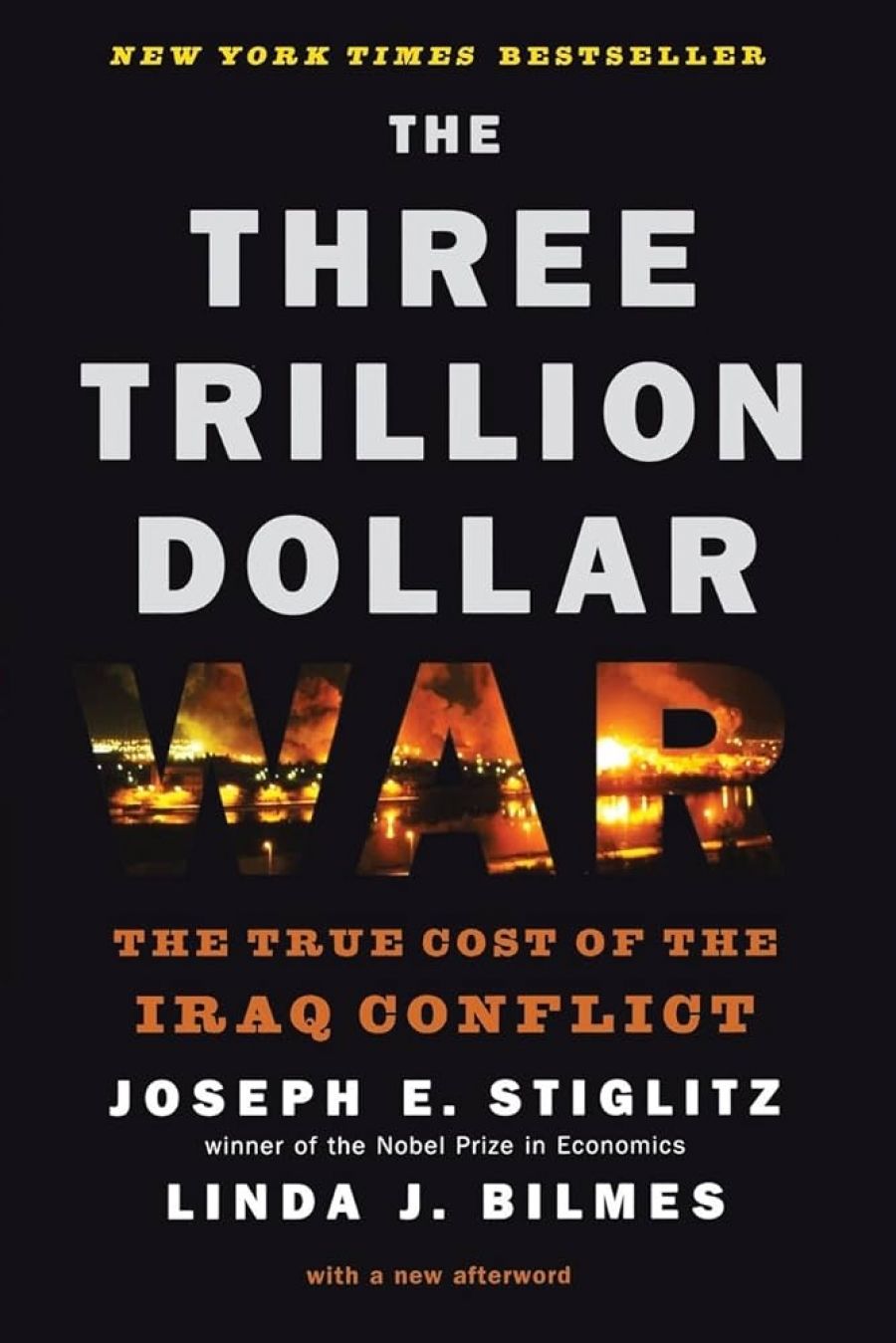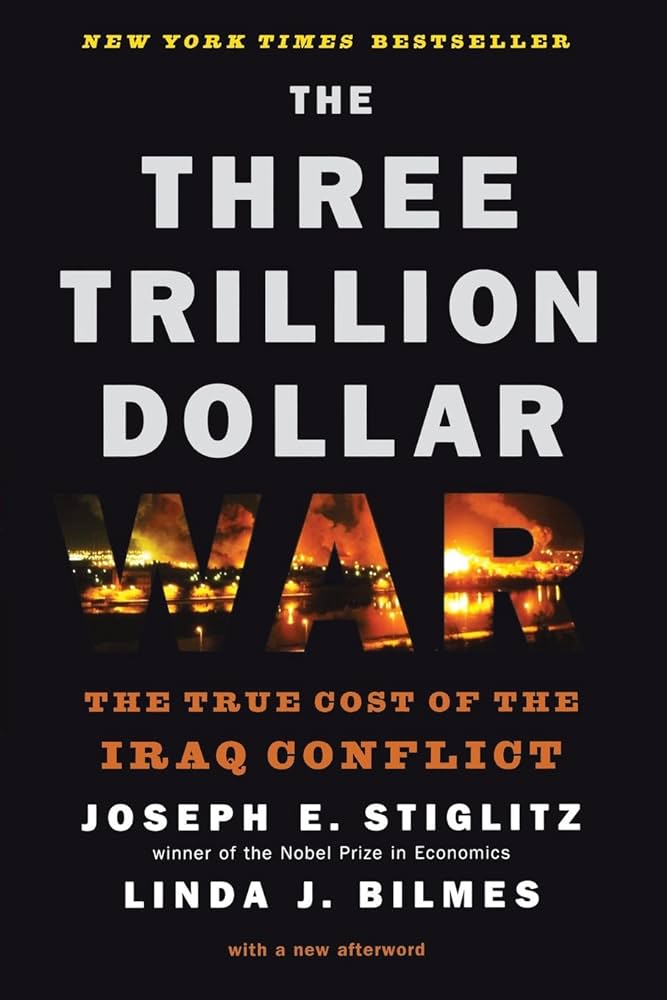
- Free Article: No
- Contents Category: War
- Custom Article Title: Burdens of war
- Review Article: Yes
- Article Title: Burdens of war
- Online Only: No
- Custom Highlight Text:
Last year, the fifth of the war, America sent another forty thousand troops to Iraq to halt the rise in violence. So far this surge seems to have worked: the number of Iraqis killed per month has fallen from over three thousand per month a year ago to under one thousand, and American combat deaths have fallen as well, from over one hundred to less than forty per month. Now the extra troops are being withdrawn again. We will see whether those grim numbers bounce back up again, and whether Iraq is any closer to the peaceful, united and pro-Western country that those who planned the invasion so blithely expected. The signs in recent weeks have not been promising.
- Book 1 Title: The Three Trillion Dollar War
- Book 1 Subtitle: The true cost of the Iraq Conflict
- Book 1 Biblio: Allen Lane, $32.95 pb, 311 pp
- Book 1 Cover Small (400 x 600):

- Book 1 Cover (800 x 1200):

The argument they present in The Three Trillion Dollar War is simple enough. The invasion and subsequent occupation of Iraq have cost the United States, and others, a lot more than its proponents predicted, and will cost a lot more still before it is over. The true scale of those costs is hidden, and needs to be uncovered to allow properly informed judgements about the original decision to invade, and about what to do next. Their book is about their attempt to calculate the bill.
Stiglitz and Bilmes spread their net wide to capture costs that can be attributed to the war. They start with an estimate of the direct costs to the American budget of military operations and reconstruction projects, but then they look at other ways in which the war hits the federal budget, including the cost of long-term care for the wounded, interest on the money being borrowed to pay for the war, and the cost of rebuilding the American military to its pre-war condition. Then they add costs to the wider American economy of things like long-term care for veterans. Finally, they factor in macro-economic costs to the economy of higher oil prices which they attribute to the war. If the occupation of Iraq lasts until 2017, they conservatively estimate that all these costs will add up to the $3 trillion of their title. And they remind us that the money to pay this huge bill is being borrowed, which shifts the real burden to future generations, and may pose real threats to America’s future economic strength.
Along the way they make some telling points. The direct cost of operations in Iraq and Afghanistan (confusingly, the two conflicts are often conflated in their analysis) is already over $800 billion. In real terms, the war has already cost more than either the Vietnam or Korean wars, and is likely to exceed that of the American involvement in World War I. The monthly cost has risen steadily to $16 billion per month, which is $138 per month for every household in America. The costs of caring for wounded veterans, including the very large numbers expected to suffer from long-term mental disorders, they estimate at $630 billion. All up, they say the war is costing Americans $25 billion per month, or not far shy of a billon dollars a day.
How much faith can be placed in these numbers? In broad terms, I would say quite a lot. Most of the time, Stiglitz and Bilmes support their arithmetic with credible arguments based on reasonable evidence and a shrewd sense of the realities of government financing. However, some of the costs they identify are unknowable, and often their conclusions are closer to informed guesswork than rigorous accountancy. And at times their arguments are tendentious, for example in blaming the invasion of Iraq for the steep oil-price rises since 2003. Iraq’s travail has not threatened disruption to global oil supplies: the oil market has been tightened by strongly growing demand and shrinking margins of unused production capacity in the big exporting countries.
Not much faith, then, should be placed in some of the detailed numbers themselves. The book’s value lies less in financial specifics than in the insights it provides into the way the American system of government works, and how it fails. As I read the book, I was reminded of a dear friend and colleague who worked for many years on Australia’s relationship with the US. ‘No wonder Americans hate big government,’ he used to say. ‘They are so bad at it.’ The authors explore the shocking inadequacy of American health care for wounded veterans, the incomprehensible opacity of Pentagon budgeting, the reckless degradation of America’s Army and National Guard by overdeployment of an undersized and overcommitted force, and the strange folly of starting a major war with a huge tax cut.
Above all, the book takes us back to reflect on the largest failure in American national decision-making for at least a generation. Five years after the invasion, a minor avalanche of memoirs and instigative journalism has given us plenty of circumstantial detail about the way the United States decided to invade Iraq, but the essence of the decision, and hence its deeper causes, remains mysterious. Stiglitz and Bilmes remind us (repeatedly, it must be said) how wildly inaccurate were the Bush administration’s prior estimates of the cost of the war, on the basis of which the decision to invade Iraq was made. Before the invasion, Larry Lindsay, who headed Bush’s National Economic Council, predicted that it would cost $200 billion. Donald Rumsfeld said that was baloney; $50–60 billion was his estimate.
This is all very telling. But how far does it take us? The Bush administration’s gross underestimation of the financial costs of the war were merely a reflection of their much deeper mistake about the scale and nature of the task they were undertaking, and the total inadequacy of their resources – not just money, but people, expertise, allies, armed force, credibility and time – to achieve the objective they had set themselves. The scale of their error reminds us that America’s Iraq project was not a good idea let down by bad execution, but a failure of conception from the outset. The Three Trillion Dollar War offers an interesting attempt to quantify the scale of this error, but it does not help us understand how it happened.
For those who simply loathe George W. Bush and his circle, as Stiglitz and Bilmes evidently do, his administration’s collective stupidity and mendacity seems to provide explanation enough. But does it? The men and women who took the Bush administration to war seem to me to have been highly intelligent and deeply experienced; I am sure that they sincerely believed they were acting in the best interests of their country, and of Iraq. A really important question therefore remains unanswered: how did they make this mistake? And why did similarly intelligent and well-intentioned people in London and Canberra come to agree with them?
Stiglitz and Bilmes pass these questions by. Likewise, they have little to say about what the United States should do now. They hate the war, but they seem to share the prevailing pessimism that the United States cannot get out of Iraq for a decade. As things stand, I think they are probably right. What will keep America in Iraq, above all else, is fear that without a major American presence, Iraq would become an Iranian satrapy and a stepping-stone to Iranian hegemony in the Gulf. To change that, America’s relationship with Iran has to change. That task will fall to the next president, who might start by wondering why there has been such enmity between Tehran and Washington over the past thirty years, and whether it need continue. The likelihood that another four thousand American soldiers will die in Iraq must be one reason to look at that question very carefully. This book provides another.


Comments powered by CComment